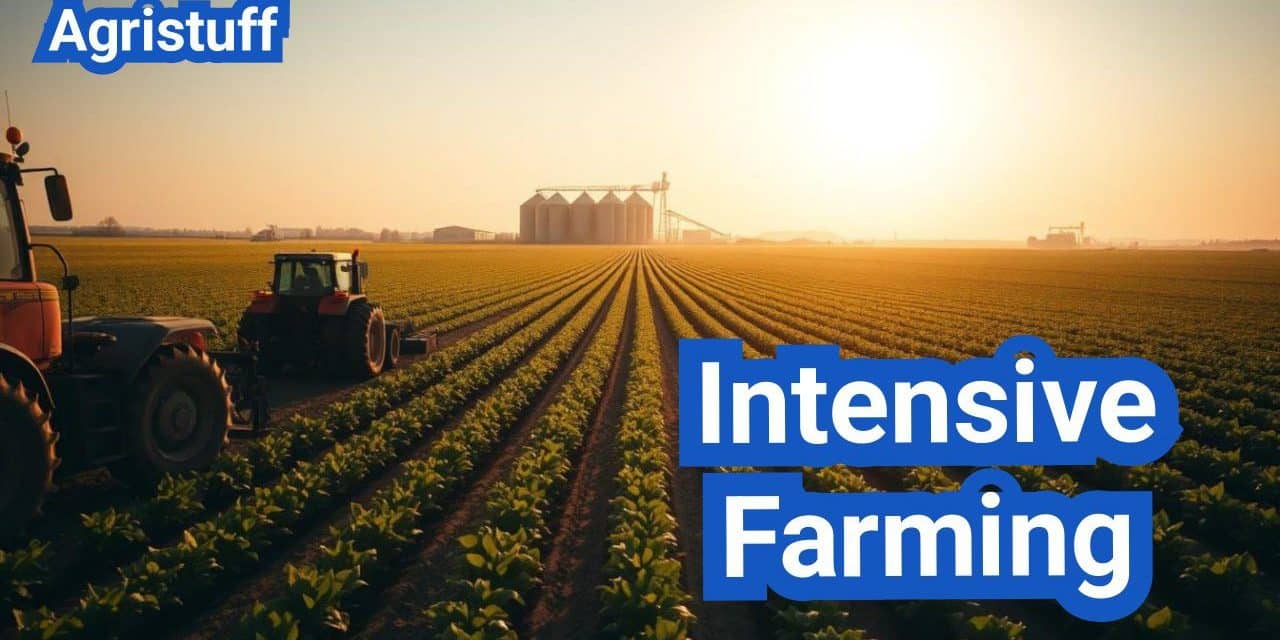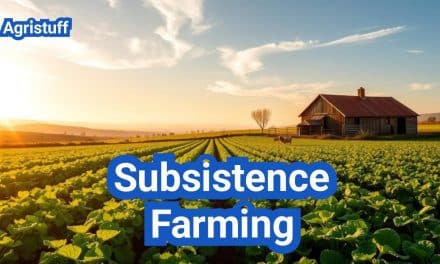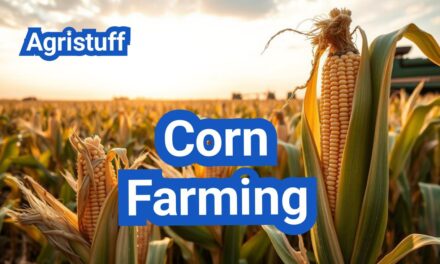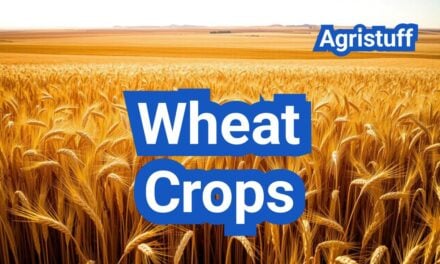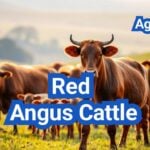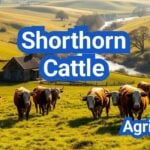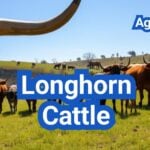Intensive farming is a method of agriculture that involves using large amounts of labor and resources to maximize the yield from a given area of land.
This approach to farming has become a cornerstone of modern agriculture, enabling farmers to produce more food on less land.
By adopting intensive cultivation practices, farmers can significantly increase crop yields and improve food security.
Key Takeaways
- Intensive farming is a method of maximizing agricultural yield.
- It involves using significant labor and resources.
- This approach is crucial for modern agriculture.
- Intensive farming helps improve food security.
- It enables farmers to produce more on less land.
What Is Intensive Farming?
The concept of intensive farming revolves around the efficient use of resources to achieve higher yields on limited land. This agricultural practice has been pivotal in meeting the world’s increasing food demands.
Definition and Core Concepts
Intensive farming is characterized by its high input of resources such as labor, capital, and technology to maximize output. The core concept is to optimize the use of land, making it highly productive. Key elements include high-yielding crop varieties, advanced irrigation systems, and the use of fertilizers and pesticides. This method contrasts with extensive farming, where larger areas are cultivated with lower inputs.
Historical Development of Agricultural Intensification
Intensive farming has its roots in ancient civilizations, where populations began to grow and agricultural productivity became crucial. Over time, advancements in technology, such as mechanization and the development of synthetic fertilizers, have driven the intensification of agriculture. The Green Revolution of the 20th century marked a significant turning point, introducing high-yielding crop varieties that further boosted productivity.
| Period | Key Developments | Impact |
|---|---|---|
| Ancient Times | Initial intensification through simple tools and irrigation | Increased food production for growing populations |
| Industrial Revolution | Mechanization and introduction of synthetic fertilizers | Significant increase in productivity and efficiency |
| 20th Century | The Green Revolution | High-yielding crop varieties, further boosting productivity |
Understanding the historical context and core concepts of intensive farming is essential for appreciating its role in modern agriculture. As the global population continues to grow, the importance of intensive farming practices will only continue to increase.
5 Key Characteristics of Intensive Farming
Intensive farming is distinguished by several key characteristics that enable it to maximize productivity and efficiency. These characteristics are fundamental to understanding how intensive farming operates and achieves its high output levels.
High Input of Resources and Capital
One of the primary characteristics of intensive farming is the high input of resources and capital. This includes significant investments in fertilizers, pesticides, machinery, and irrigation systems. The use of these resources allows farmers to control and optimize growing conditions, leading to higher yields and better crop quality.
Maximized Land Productivity and Yields
Intensive farming is focused on maximizing land productivity and yields. This is achieved through the use of high-yielding crop varieties, intensive crop rotation, and other techniques that ensure the land is used as efficiently as possible. The result is a significant increase in the amount of produce generated per acre.
Advanced Technology Implementation
The implementation of advanced technology is another key characteristic of intensive farming. This includes the use of precision agriculture techniques, drones, satellite imaging, and automated farming equipment. These technologies help farmers to monitor and manage their crops more effectively, reducing waste and improving productivity.
Specialized Production Systems
Intensive farming often involves specialized production systems tailored to specific crops or livestock. This specialization allows farmers to optimize their practices for the particular needs of their crops or animals, leading to more efficient and productive farming operations.
| Characteristic | Description | Benefit |
|---|---|---|
| High Input of Resources and Capital | Significant investments in fertilizers, pesticides, machinery, and irrigation systems. | Higher yields and better crop quality. |
| Maximized Land Productivity and Yields | Use of high-yielding crop varieties and intensive crop rotation. | Increased produce per acre. |
| Advanced Technology Implementation | Precision agriculture techniques, drones, satellite imaging, and automated equipment. | Improved monitoring and management, reduced waste. |
| Specialized Production Systems | Tailored practices for specific crops or livestock. | More efficient and productive farming operations. |
Intensive Farming vs. Extensive Farming

Intensive farming and extensive farming represent two distinct approaches to agricultural production, each with its own set of characteristics and implications. While intensive farming focuses on maximizing output from a given area of land through high inputs of resources and advanced technology, extensive farming takes a more traditional approach, relying on natural resources and covering larger areas.
Land Use and Productivity Differences
One of the primary differences between intensive and extensive farming lies in land use and productivity. Intensive farming is characterized by high yields from a relatively small area of land, achieved through the use of advanced agricultural techniques and technology. In contrast, extensive farming covers larger areas but typically results in lower yields per hectare due to its reliance on natural rainfall and soil fertility.
Resource and Labor Requirements
The resource and labor requirements for intensive and extensive farming also differ significantly. Intensive farming requires substantial inputs of capital, labor, and resources, including fertilizers, pesticides, and irrigation systems. Extensive farming, on the other hand, relies more on natural resources and tends to have lower labor requirements per unit of land.
Economic and Environmental Considerations
Economic and environmental considerations play a crucial role in determining the viability of intensive and extensive farming practices. Intensive farming can offer higher economic returns due to its high productivity, but it also poses significant environmental risks, such as soil degradation and water pollution. Extensive farming, while potentially more environmentally friendly, may not be as economically viable due to its lower productivity.
In conclusion, the choice between intensive and extensive farming depends on a variety of factors, including land availability, economic conditions, and environmental concerns. Understanding the differences between these two approaches is essential for developing sustainable agricultural practices that balance productivity with environmental stewardship.
Major Types of Intensive Farming Systems
Intensive farming systems can be categorized into several major types based on their operational methods and objectives. These systems are designed to maximize productivity and efficiency, often leveraging advanced technology and management practices.
Intensive Commercial Farming Operations
Intensive commercial farming operations are large-scale agricultural enterprises focused on producing high volumes of crops or livestock for market. These operations typically employ advanced technology, including precision agriculture techniques and mechanized equipment, to maximize efficiency and reduce labor costs. High-yielding crop varieties and specialized livestock breeds are often used to enhance productivity.
Intensive Subsistence Farming in Developing Regions
In contrast to commercial operations, intensive subsistence farming is practiced in many developing regions where farmers rely heavily on their produce for food security. These farming systems are characterized by high labor input and efficient use of small landholdings. Techniques such as intercropping and crop rotation are commonly used to maximize yields on limited land.
Intensive Factory Farming and Industrial Agriculture
Intensive factory farming, also known as industrial agriculture, involves the large-scale production of livestock or crops using industrial methods. This type of farming is characterized by confined animal feeding operations (CAFOs) for livestock and monoculture cropping systems for crops. The focus is on maximizing output while minimizing costs, often through the use of specialized equipment and technology.
Bio-Intensive and Biointensive Permaculture Methods
Bio-intensive farming methods focus on sustainable practices that enhance soil health and biodiversity while maintaining high productivity. Techniques include composting, polyculture, and minimal external input. Biointensive permaculture takes this a step further by designing farming systems that mimic natural ecosystems, promoting ecological balance and resilience.
The diversity of intensive farming systems reflects the complexity of global agricultural needs and practices. Understanding these different approaches is crucial for addressing food security challenges and promoting sustainable agriculture.
How to Implement Intensive Crop Production

Intensive crop production involves a series of strategic practices to enhance crop yields. This approach is crucial for maximizing productivity on limited land, ensuring food security, and maintaining economic viability for farmers.
Selecting Suitable Crops for Intensive Cultivation
Choosing the right crops is fundamental to successful intensive farming. High-yielding varieties that are resistant to pests and diseases should be prioritized. Crops such as maize, wheat, and soybeans are commonly used in intensive farming due to their high productivity and market demand.
Implementing Effective Crop Rotation Strategies
Crop rotation is essential for maintaining soil health and reducing pest and disease pressure. Rotating crops like legumes with cereals can enhance soil fertility and structure. A well-planned rotation can also improve crop yields and reduce the need for chemical inputs.
Optimizing Fertilization and Nutrient Management
Effective fertilization is critical for intensive crop production. Soil testing should be conducted regularly to determine nutrient levels and pH. Based on these tests, farmers can apply the appropriate type and amount of fertilizers to meet the crop’s nutritional needs.
Developing Irrigation and Water Management Systems
Adequate water supply is vital for intensive farming. Irrigation systems should be designed to deliver water efficiently, minimizing waste and ensuring that crops receive the right amount of moisture. Techniques such as drip irrigation can significantly reduce water usage while maintaining high yields.
By implementing these strategies, farmers can achieve higher productivity and sustainability in their intensive crop production systems.
Intensive Livestock Production Techniques
The global demand for meat, dairy, and aquaculture products has led to the development of intensive livestock production techniques. These methods are designed to maximize efficiency and productivity while minimizing environmental impact.
Setting Up Concentrated Animal Feeding Operations (CAFOs)
Concentrated Animal Feeding Operations (CAFOs) are large-scale facilities that house a significant number of animals in a confined area. CAFOs are designed to optimize feeding efficiency, animal health, and waste management. Efficient waste management is crucial in CAFOs to prevent environmental pollution.
The setup of CAFOs involves careful planning, including the selection of suitable locations, design of facilities, and implementation of feeding and waste management systems.
Managing Intensive Dairy Farming Systems
Intensive dairy farming systems focus on maximizing milk production per cow through advanced breeding programs, nutrition management, and health care. These systems often incorporate technology such as automated milking systems and data analytics to monitor cow health and productivity.
“The use of technology in dairy farming has revolutionized the industry, enabling farmers to produce high-quality milk while improving cow welfare.” – Dairy Farmer
Implementing Intensive Aquaculture Methods
Intensive aquaculture involves the cultivation of fish and other seafood in controlled environments, such as recirculating aquaculture systems (RAS). These systems allow for precise control over water quality, temperature, and feeding, resulting in high productivity and reduced environmental impact.
| Method | Description | Benefits |
|---|---|---|
| CAFOs | Large-scale animal feeding operations | Efficient waste management, optimized feeding |
| Intensive Dairy Farming | Maximizing milk production per cow | Advanced breeding, nutrition management |
| Intensive Aquaculture | Cultivation in controlled environments | Precise control over water quality, high productivity |
By adopting these intensive livestock production techniques, farmers can improve productivity, reduce environmental impact, and meet the growing demand for animal products.
Modern Technologies Transforming Intensive Farming

Technological advancements are at the forefront of intensive farming’s evolution, driving innovation and efficiency. The integration of modern technologies is revolutionizing the way farmers cultivate crops and raise livestock, making intensive farming more productive and sustainable.
Applying Precision Agriculture Techniques
Precision agriculture is a key component of modern intensive farming. By utilizing GPS, sensors, and drones, farmers can optimize crop yields, reduce waste, and minimize environmental impact. Precision agriculture techniques enable farmers to make data-driven decisions, improving crop management and resource allocation.
Integrating Automation and Robotics
Automation and robotics are transforming intensive farming by increasing efficiency and reducing labor costs. Automated systems can monitor and manage crops, detect issues, and apply precise amounts of water and fertilizers. Robotic farming equipment is also being used for tasks such as pruning, harvesting, and weeding, further reducing the need for manual labor.
“The use of automation and robotics in farming is not just about increasing efficiency; it’s also about improving crop quality and reducing environmental impact.”
Utilizing Data Analytics and Smart Farming Solutions
Data analytics plays a crucial role in intensive farming, enabling farmers to analyze data from various sources, including weather stations, soil sensors, and crop monitoring systems. By leveraging data analytics and smart farming solutions, farmers can gain valuable insights into their operations, making informed decisions to optimize production and reduce costs.
| Technology | Application | Benefits |
|---|---|---|
| Precision Agriculture | Crop monitoring, yield optimization | Increased efficiency, reduced waste |
| Automation and Robotics | Task automation, labor reduction | Improved productivity, reduced labor costs |
| Data Analytics | Data-driven decision making | Optimized production, cost reduction |
In conclusion, modern technologies are transforming intensive farming practices, enhancing efficiency, productivity, and sustainability. By embracing these technologies, farmers can improve crop yields, reduce environmental impact, and contribute to a more food-secure future.
Soil Health Management in Intensive Farming

Soil health management plays a vital role in ensuring the sustainability of intensive farming systems. It involves a combination of practices that help maintain or improve the soil’s physical, chemical, and biological properties.
Building and Maintaining Soil Organic Matter
Soil organic matter is crucial for maintaining soil structure, facilitating water infiltration, and supporting soil biota. To build and maintain soil organic matter, farmers can incorporate cover crops into their rotation, apply organic amendments such as compost or manure, and minimize tillage to reduce soil disturbance.
- Incorporating cover crops to enhance soil organic matter
- Applying organic amendments like compost or manure
- Reducing tillage to minimize soil disturbance
Implementing Biological Intensive Nutrient Management
Biological intensive nutrient management involves using microorganisms and other biological processes to optimize nutrient availability for crops. This can include practices such as inoculating seeds with beneficial microbes and using organic fertilizers that support soil biota.
- Inoculating seeds with beneficial microbes to enhance nutrient uptake
- Using organic fertilizers that promote soil biological activity
Conducting Regular Soil Testing and Monitoring
Regular soil testing is essential for understanding soil health and making informed management decisions. By monitoring soil pH, nutrient levels, and soil structure, farmers can identify potential issues early and take corrective action.
Effective soil health management is a cornerstone of sustainable intensive farming. By focusing on building soil organic matter, implementing biological intensive nutrient management, and conducting regular soil testing, farmers can improve crop yields, reduce environmental impacts, and ensure the long-term viability of their operations.
Greenhouse and Controlled Environment Agriculture

The use of greenhouses and controlled environments is becoming increasingly important in modern agriculture. This method allows for the precise control of growing conditions, resulting in higher yields and more efficient use of resources.
Efficient Growing Structures
Designing efficient growing structures is crucial for greenhouse and controlled environment agriculture. This involves selecting materials that provide optimal insulation and light transmission, as well as configuring the layout to maximize space and promote air circulation. Efficient design can significantly reduce energy costs and improve crop health.
Climate Control Systems
Implementing climate control systems is vital for maintaining optimal growing conditions. These systems regulate temperature, humidity, and light levels, ensuring that crops receive the best possible conditions for growth. Advanced climate control systems can be integrated with sensors and automation technology to optimize performance.
Hydroponic and Aeroponic Systems
Setting up hydroponic and aeroponic systems allows for the precise delivery of nutrients to crops. Hydroponics involves growing plants in a nutrient-rich solution rather than soil, while aeroponics uses a fine mist to deliver nutrients. Both methods can significantly increase crop yields and reduce water usage.
Energy Efficiency Measures
Optimizing energy efficiency measures is critical for reducing the environmental impact of greenhouse and controlled environment agriculture. This can be achieved through the use of LED grow lights, renewable energy sources, and advanced insulation materials. By minimizing energy consumption, growers can reduce their operational costs and environmental footprint.
By combining these elements, greenhouse and controlled environment agriculture can provide a highly productive and sustainable method for crop production. As the global demand for food continues to grow, these systems will play an increasingly important role in meeting future agricultural needs.
Advantages of Intensive Farming Practices

The advantages of intensive farming are multifaceted, contributing to global food security and economic development. Intensive farming practices have become a crucial component in meeting the world’s growing food demands.
Maximizing Food Production and Yields
One of the primary benefits of intensive farming is its ability to maximize food production and yields. By utilizing advanced technology, high-yielding crop varieties, and optimized farming techniques, farmers can significantly increase their output. This not only helps to meet the growing demand for food but also contributes to food security, particularly in regions with high population densities.
Generating Economic Benefits and Profitability
Intensive farming also generates substantial economic benefits and profitability for farmers. By adopting intensive farming methods, farmers can improve their crop yields, reduce production costs, and increase their overall revenue. This, in turn, can have a positive impact on the local economy, creating jobs and stimulating economic growth.
Enabling Year-Round Production Capabilities
Another significant advantage of intensive farming is its ability to enable year-round production capabilities. Through the use of controlled environment agriculture, greenhouses, and other advanced farming techniques, farmers can produce crops throughout the year, regardless of the season or weather conditions. This helps to ensure a consistent food supply, which is essential for meeting the demands of a growing global population.
Environmental Challenges of Intensive Farming

Intensive farming, while productive, poses significant environmental challenges that need to be addressed. The high demand for resources and the intensive use of land can lead to various environmental issues.
Addressing Water Usage and Pollution Concerns
Intensive farming often requires substantial water resources, leading to potential water scarcity issues. Moreover, the use of fertilizers and pesticides can result in water pollution, affecting both surface and groundwater quality.
Mitigating Biodiversity Loss and Habitat Destruction
The expansion of intensive farming can lead to habitat destruction and loss of biodiversity as natural ecosystems are converted into agricultural land. This not only affects wildlife but also reduces ecosystem services that are crucial for long-term agricultural productivity.
Reducing Greenhouse Gas Emissions
Intensive farming practices can contribute to greenhouse gas emissions through the use of machinery, fertilizers, and other inputs. Strategies to reduce these emissions include improving energy efficiency and adopting practices that enhance soil carbon sequestration.
Preventing Chemical Runoff and Contamination
The use of chemicals in intensive farming can lead to runoff and contamination of soil and water. Implementing integrated pest management strategies and using more targeted and efficient application methods can help mitigate these issues.
Food Security Through Intensive Farming

As the global demand for food continues to rise, intensive farming emerges as a critical solution. With the world’s population projected to reach 9.7 billion by 2050, the pressure on agricultural systems to produce more food is intensifying. Intensive farming, characterized by its high-yielding practices and efficient use of resources, is pivotal in addressing this challenge.
Meeting Growing Global Food Demand
Intensive farming is instrumental in meeting the growing global food demand. By leveraging advanced agricultural technologies and practices, such as precision agriculture and high-yielding crop varieties, intensive farming can significantly boost crop yields. For instance, the use of precision agriculture techniques can enhance crop yields by up to 20% while reducing water and fertilizer usage.
| Region | Current Yield (tons/hectare) | Potential Yield with Intensive Farming (tons/hectare) |
|---|---|---|
| Asia | 3.5 | 5.5 |
| Africa | 2.0 | 4.0 |
| Europe | 4.0 | 6.0 |
Improving Food Distribution Systems
Besides increasing food production, intensive farming also plays a role in improving food distribution systems. By locating farms closer to consumption centers and utilizing efficient logistics, the supply chain can be optimized, reducing food waste and improving food security. For example, vertical farming in urban areas can provide fresh produce to city dwellers, reducing transportation costs and environmental impact.
Building Resilience to Climate Change
Intensive farming can also contribute to building resilience to climate change. Practices such as crop rotation, soil conservation, and the use of climate-resilient crop varieties can help mitigate the impacts of climate change on food production. Moreover, intensive farming systems that incorporate renewable energy sources, like solar-powered irrigation, can further reduce their carbon footprint.
In conclusion, intensive farming is a multifaceted approach to ensuring food security. By enhancing crop yields, improving distribution systems, and building resilience to climate change, intensive farming can play a vital role in meeting the world’s growing food needs.
Animal Welfare Considerations in Intensive Farming

As intensive farming continues to grow, so does the importance of addressing animal welfare considerations. Intensive farming systems, characterized by high stocking densities and specialized production systems, can pose significant challenges to animal welfare.
Common Welfare Concerns
Intensive farming raises several animal welfare concerns, including confinement, feeding practices, and health issues. For instance, high stocking densities can lead to stress and increased susceptibility to diseases among animals.
Regulatory Frameworks and Standards
Understanding regulatory frameworks and standards is crucial for addressing animal welfare concerns. Various countries have established guidelines and laws to protect animal welfare in intensive farming operations.
| Country | Regulatory Framework | Key Provisions |
|---|---|---|
| United States | Animal Welfare Act | Sets standards for animal care in research, exhibition, and transport |
| European Union | EU Animal Welfare Directives | Covers welfare standards for farm animals, including housing and transport conditions |
Welfare-Focused Management Practices
Implementing welfare-focused management practices is essential for improving animal welfare in intensive farming. This includes providing adequate housing, ensuring proper nutrition, and implementing health management strategies.
Responding to Consumer Awareness and Market Pressure
Consumer awareness and market pressure play a significant role in shaping animal welfare standards in intensive farming. Producers are increasingly adopting welfare-friendly practices in response to consumer demand for higher welfare standards.
In conclusion, addressing animal welfare considerations in intensive farming requires a multifaceted approach that includes understanding welfare concerns, adhering to regulatory frameworks, implementing welfare-focused management practices, and responding to consumer awareness and market pressure.
Sustainable Approaches to Intensive Farming
As the world grapples with food security challenges, sustainable intensive farming has emerged as a crucial strategy. This approach involves integrating practices that not only maximize yields but also minimize environmental impact.
Integrating Regenerative Agriculture Principles
Regenerative agriculture focuses on enhancing soil health, biodiversity, and ecosystem services. By adopting regenerative practices, intensive farming can become more sustainable and resilient. This includes techniques like cover cropping, reduced tillage, and organic amendments.
Adopting Integrated Pest Management Strategies
Integrated Pest Management (IPM) is a holistic approach that combines physical, cultural, biological, and chemical controls to manage pests. IPM reduces the reliance on chemical pesticides, minimizing environmental pollution and promoting ecosystem balance.
Implementing Water Conservation Techniques
Water conservation is critical in intensive farming. Techniques such as drip irrigation, mulching, and precision agriculture help reduce water waste and optimize water use. These methods not only conserve water but also reduce the energy required for water pumping and treatment.
Incorporating Renewable Energy Solutions
The use of renewable energy in intensive farming can significantly reduce the carbon footprint of agricultural operations. Solar-powered irrigation systems, wind energy for farm operations, and bioenergy from agricultural waste are examples of renewable energy solutions that can be integrated into intensive farming practices.
By adopting these sustainable approaches, intensive farming can become more environmentally friendly, economically viable, and socially responsible. It’s a step towards ensuring food security while preserving natural resources for future generations.
The Future of Intensive Farming
The future of intensive farming is closely tied to its ability to adopt sustainable practices that balance high productivity with environmental stewardship. As the global population continues to grow, intensive farming practices will play a crucial role in meeting the increasing demand for food.
Sustainable intensive farming methods, such as regenerative agriculture and integrated pest management, can help mitigate the environmental challenges associated with intensive farming. By incorporating these approaches, farmers can reduce their reliance on chemical inputs, conserve water, and promote biodiversity.
The adoption of advanced technologies, including precision agriculture and data analytics, will also be essential in shaping the future of intensive farming. These innovations can help farmers optimize resource use, improve crop yields, and minimize environmental impacts.
Ultimately, the success of intensive farming in the future will depend on its ability to strike a balance between productivity and sustainability. By embracing sustainable intensive farming practices, the agricultural sector can ensure a food-secure future while protecting the environment.
FAQ
What are the main characteristics of intensive farming?
Intensive farming is characterized by high input of resources and capital, maximized land productivity and yields, advanced technology implementation, and specialized production systems.
How does intensive farming differ from extensive farming?
Intensive farming involves high-input, high-yield practices on a smaller land area, whereas extensive farming uses larger land areas with lower input and yield per unit.
What are the different types of intensive farming?
The major types of intensive farming include intensive commercial farming, intensive subsistence farming, factory farming, and bio-intensive methods.
How can intensive farming be made more sustainable?
Sustainable approaches to intensive farming include integrating regenerative agriculture principles, adopting integrated pest management strategies, implementing water conservation techniques, and incorporating renewable energy solutions.
What are the environmental impacts of intensive farming?
Intensive farming can lead to water usage and pollution, biodiversity loss, greenhouse gas emissions, and chemical runoff, but strategies can be implemented to mitigate these challenges.
How does intensive farming contribute to food security?
Intensive farming helps meet growing global food demand, improves food distribution systems, and builds resilience to climate change, thus contributing to food security.
What are the concerns regarding animal welfare in intensive farming?
Common welfare concerns in intensive farming include confinement, lack of access to natural environments, and stress, which can be addressed through welfare-focused management practices and regulatory frameworks.
What role does technology play in intensive farming?
Modern technologies such as precision agriculture, automation, and data analytics are transforming intensive farming by improving efficiency, productivity, and sustainability.
How can soil health be managed in intensive agriculture?
Soil health management in intensive farming involves building and maintaining soil organic matter, implementing biological intensive nutrient management, and conducting regular soil testing and monitoring.
What is the significance of greenhouse and controlled environment agriculture?
Greenhouse and controlled environment agriculture enable year-round production, improve crop yields, and reduce environmental impacts through optimized growing conditions and climate control.
What are the benefits of intensive farming practices?
Intensive farming practices maximize food production and yields, generate economic benefits and profitability, and enable year-round production capabilities, contributing to food security and economic development.
Conclusion of: Intensive Farming
Intensive farming, often referred to as industrial agriculture, is a modern farming practice designed to maximize production by using significant inputs such as chemical fertilizers, pesticides, advanced technology, and high-yield crop varieties. The primary aim of intensive farming is to produce the maximum possible yield from a minimum amount of land. This approach has been central to meeting the global food demands of an ever-growing population.
What is Intensive Farming?
Intensive farming is a method of agricultural production characterized by a high input of resources relative to the land area. This farming technique heavily depends on chemical fertilizers, pesticides, mechanization, and other resources aimed at maximizing yield. It can be practiced on both crop cultivation and animal farming, leading to significantly higher productivity compared to traditional methods.
An authoritative source that offers additional insights on intensive farming can be found here.
Types of Intensive Farming
Intensive farming practices include crop production and livestock farming. Crop production involves cultivating high-yield varieties with the intensive application of fertilizers, pesticides, and irrigation. Livestock farming under intensive systems involves high-density animal housing with regular use of antibiotics and growth hormones.
Detailed insights on the types of intensive farming are discussed comprehensively on the USDA website here.
Methods of Intensive Farming
Common methods used in intensive farming include monoculture, hydroponics, vertical farming, and factory farming. Monoculture involves growing a single type of crop extensively, hydroponics refers to growing plants without soil, vertical farming is a practice of growing crops in vertically stacked layers, and factory farming pertains to raising large numbers of livestock in confined spaces.
For further reading on intensive farming methods, visit this authoritative resource.
Benefits of Intensive Farming
Intensive farming significantly increases food production, enabling food security and stable food prices. By maximizing the yield from limited land resources, intensive farming reduces the pressure to clear more land for agriculture, thus protecting forests and biodiversity. Additionally, modern techniques such as vertical farming allow for urban agricultural practices.
An insightful exploration of intensive farming benefits is available here.
Challenges and Criticism of Intensive Farming
Despite its benefits, intensive farming is not without criticism. Environmental concerns include soil degradation, water pollution from chemical runoff, and loss of biodiversity. There are also concerns about animal welfare due to confined living conditions in intensive livestock operations. Moreover, excessive use of antibiotics in animal farming has led to growing antimicrobial resistance.
More comprehensive details about these challenges can be accessed from this resource.
Environmental Impact of Intensive Farming
Intensive farming has profound environmental impacts, including significant contributions to greenhouse gas emissions, soil erosion, and chemical runoff leading to water pollution. The heavy reliance on chemical inputs can adversely affect ecosystems and biodiversity, resulting in ecological imbalances.
Read more about the environmental impacts here.
Intensive Farming and Sustainability
As sustainability becomes increasingly important, intensive farming practices are evolving. Innovations like precision agriculture, integrated pest management (IPM), and organic farming methods aim to reduce environmental impacts while maintaining high productivity levels. These methods incorporate technological advancements and more sustainable resource management practices.
Additional sustainable intensive farming practices can be explored here.
Intensive Farming and Technology
Technological advancements have revolutionized intensive farming, making it more efficient and productive. Precision agriculture uses GPS technology, drones, and data analytics to optimize resource use, significantly reducing waste and environmental damage. Automated machinery and robotics further improve operational efficiency.
Learn more about technology in intensive farming here.
Future of Intensive Farming
The future of intensive farming looks promising with continued innovation. Technological advancements, coupled with growing awareness of environmental sustainability, are likely to lead to improved methods that mitigate negative impacts. Emphasis on sustainable practices and technological integration will continue to shape the future of intensive farming.
Gain further insights into the future outlook of intensive farming from this site.
Intensive Farming vs. Extensive Farming
Intensive farming differs significantly from extensive farming, where extensive farming relies on larger land areas with minimal inputs, leading to lower yields but fewer environmental impacts. Intensive farming, conversely, focuses on high production outputs from limited land through substantial input use.
To delve deeper into this comparison, visit this comprehensive guide.
Intensive Farming Regulations
Intensive farming practices are subject to regulations designed to mitigate environmental impacts and safeguard animal welfare. Regulatory frameworks vary globally but generally focus on sustainable resource use, chemical restrictions, waste management, and animal welfare standards.
For detailed regulatory information, you can explore this resource.
Intensive Farming Examples
Examples of intensive farming include large-scale poultry farms, monoculture plantations such as corn and soybeans, and advanced urban vertical farms. Each of these examples demonstrates the high-yield potential of intensive farming methods.
Explore more intensive farming examples here.
Final Thought
Intensive farming has dramatically transformed global agriculture, offering significant benefits in food production. However, it is essential to address its environmental and ethical concerns through sustainable innovations and regulated practices to ensure a balanced and sustainable future.

